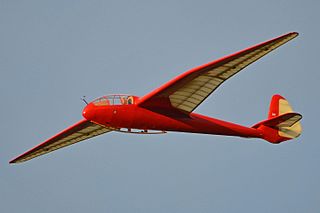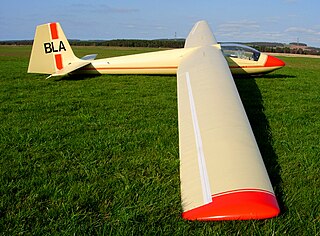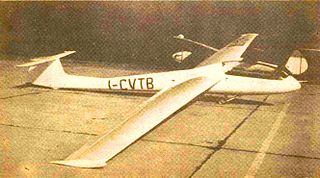
The Slingsby T.41 Skylark 2 was a sailplane produced from 1953 by Slingsby Sailplanes at Kirkbymoorside, Yorkshire.

The Slingsby Type 42 Eagle was a two-seat glider designed in England from 1952.

The Slingsby T.37 Skylark 1 was a small low-cost sailplane built during 1952-3 at Kirbymoorside, Yorkshire by Slingsby Sailplanes.

The Slingsby T.12 Gull was a British single-seat glider designed and built by Slingsby Sailplanes and first flown in 1938.

The Slingsby Type 34 Sky is a high performance single seat competition sailplane built in the United Kingdom. It was successful in major events, particularly in the World Gliding Championships of 1952.

The Slingsby Type 51 Dart is a single seat competition glider designed in the early 1960s, initially as a 15 m span Standard Class aircraft but evolved into an Open Class, 17 m sailplane. It was the last Slingsby sailplane to be mostly constructed of wood.

The Slingsby T.30 Prefect is a 1948 British modernisation of the 1932 single-seat Grunau Baby glider. About 53 were built for civil and military training purposes.
The Slingsby Type 26 Kite 2 was a post World War II development of the Slingsby Kite, a single seat medium performance sailplane. It sold in small numbers.

The Slingsby Type 45 Swallow was designed as a club sailplane of reasonable performance and price. One of the most successful of Slingsby's gliders in sales terms, over 100 had been built when production was ended by a 1968 factory fire.

The Slingsby T.13 Petrel was a British single-seat competition glider built by Slingsby Sailplanes just before World War II.

The Slingsby T.50 Skylark 4 was a British single seat competition glider built by Slingsby Sailplanes in the early 1960s. It sold in numbers and had success at national, though not world level competition.
The Broburn Wanderlust was a small, wooden, single-seat glider designed in the United Kingdom just after World War II. Only one was built, though it was well used.
The Peak 100 was a side-by-side two-seat high performance sailplane, featuring a steel-framed fuselage, designed in the United Kingdom in the early 1960s. Only one was built.

The Cijan-Obad Orao is a competition single seat sailplane designed in Yugoslavia just after World War II, one of the most advanced of its type at the time. It flew in three World Gliding Championships, having greatest success at its first in 1950 when it reached third place.

The Ikarus Meteor is a long-span, all-metal sailplane designed and built in Yugoslavia in the 1950s. It competed in World Gliding Championships (WGC) between 1956 and 1968 and was placed fourth in 1956; it also set new triangular-course world speed records.
The UTG-1 Loudon was an intermediate glider designed and built at the University of Toronto in Canada during the late 1940s.
The IS-3 was the basis of a family of high performance gliders designed by Iosif Şilimon and built in Romania in the 1950s at the URMV-3 factory at Braşov.

The CVT2 Veltro was an Italian competition glider built in the mid-1950s. Its advanced design incorporated a laminar flow wing, T-tail, retracting undercarriage and a reclining seat to reduce parasitic drag.

The RRG Falke of 1930 was a secondary training glider designed by Alexander Lippisch in Germany and intended to provide better performance than his earlier RRG Prüfling whilst being easier to fly because of its inherent stability. It was sold as plans for both club and commercial production and was built in Germany and abroad.

The Oberlerchner Mg 19 Steinadler is an Erwin Musger designed two seat tandem trainer glider built in Austria and first flown in 1951. Several examples of this successful aircraft, which competed in the two seat class at two World Gliding Championships in the 1950s, were still flying in 2000.















